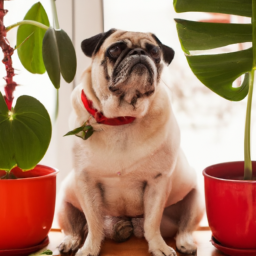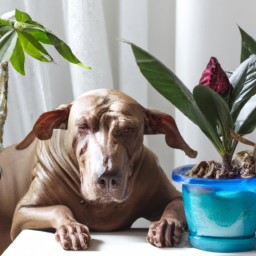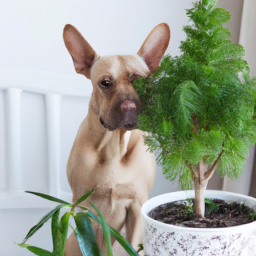
Are you a proud dog owner who loves to fill your home with beautiful indoor plants? While indoor plants can add a touch of greenery and freshness to any living space, it’s crucial to be aware of the potential dangers they can pose to our furry friends. In this blog post, we’ll be discussing a topic that every dog owner should be well-informed about: indoor plants toxic to dogs. It’s important to know which plants can be harmful to our canine companions, so we can create a safe and pet-friendly environment for them to thrive in. So, let’s dive in and explore some common indoor plants that can be toxic to dogs and learn how to keep our four-legged friends safe and healthy.
Common Indoor Plants That Are Toxic to Dogs
As a dog owner, it is essential to be aware of the potential dangers that certain indoor plants can pose to our furry friends. While indoor plants can add beauty and freshness to our homes, some of them can be toxic to dogs if ingested. In this guide, we will explore the common indoor plants that are toxic to dogs, their symptoms, and what to do if your dog comes into contact with them.
1. Sago Palm
The Sago Palm, scientifically known as Cycas revoluta, is a popular choice for indoor decoration due to its attractive foliage. However, it is crucial to keep this plant out of reach of your dogs as it is highly toxic to them. The entire plant, including the seeds, is poisonous and can cause severe symptoms such as vomiting, diarrhea, liver failure, and even death if ingested by dogs.
If you suspect that your dog has ingested any part of the Sago Palm, it is essential to seek immediate veterinary assistance. The veterinarian may induce vomiting or administer activated charcoal to prevent further absorption of the toxins. Supportive care, including intravenous fluids and medications, may also be necessary to treat any complications that arise.
To keep your dog safe, consider opting for dog-friendly indoor plants such as Boston Fern, Spider Plant, or Areca Palm, which can provide a green touch to your home without posing a risk to your furry friend.
2. Peace Lily
The Peace Lily, also known as Spathiphyllum, is a popular choice for indoor plants due to its elegant white flowers and glossy green leaves. However, this plant contains calcium oxalate crystals, which can cause severe discomfort if ingested by dogs. Symptoms may include drooling, difficulty swallowing, vomiting, and oral irritation.
If your dog has come into contact with the Peace Lily, it is essential to rinse their mouth with water to remove any plant residue. Offer them small amounts of milk or water to help soothe their mouth. If symptoms persist or worsen, consult your veterinarian for further guidance.
Consider replacing the Peace Lily with dog-friendly alternatives such as the Boston Fern, Bamboo Palm, or African Violet, which can add beauty to your indoor space without posing a risk to your furry companion.
3. Dieffenbachia
The Dieffenbachia, also known as Dumb Cane, is a popular decorative plant known for its large, patterned leaves. However, it contains calcium oxalate crystals, similar to the Peace Lily, which can cause oral irritation and discomfort if ingested by dogs. Symptoms may include drooling, difficulty swallowing, and vomiting.
If your dog has come into contact with the Dieffenbachia, it is essential to rinse their mouth with water and offer them small amounts of milk or water to alleviate any discomfort. Monitor their symptoms closely, and if they persist or worsen, seek veterinary assistance.
Consider replacing the Dieffenbachia with dog-friendly alternatives such as the Parlor Palm, Boston Fern, or Calathea, which can provide a safe and visually appealing environment for both you and your dog.
It is crucial to remember that this guide provides general information about common indoor plants that are toxic to dogs. However, there are many other plants that can be harmful to dogs, so it is always advisable to research any new plants you bring into your home to ensure they are safe for your furry friend.
By being aware of the potential dangers and taking necessary precautions, you can create a safe and dog-friendly indoor environment where both you and your beloved pet can thrive.

Indoor Plants Toxic to Dogs
2. Symptoms of Plant Toxicity in Dogs
As a responsible dog owner, it’s crucial to be aware of the potential dangers that certain indoor plants can pose to your furry friend. While plants bring beauty and freshness to our homes, some can be toxic to dogs if ingested. Understanding the symptoms of plant toxicity in dogs is essential in order to identify and address any potential issues promptly. In this guide, we will discuss common symptoms that may indicate your dog has been exposed to toxic plants and what actions you should take.
1. Gastrointestinal Disturbances
One of the most common symptoms of plant toxicity in dogs is gastrointestinal disturbances. If your dog has ingested a toxic plant, you may notice symptoms such as vomiting, diarrhea, and excessive drooling. These symptoms can vary in severity depending on the type and amount of plant consumed. It’s important to monitor your dog closely and contact your veterinarian if these symptoms persist or worsen.
In some cases, dogs may also experience abdominal pain or discomfort. They may exhibit signs of restlessness, pacing, or reluctance to lie down. If you observe any of these behaviors along with gastrointestinal disturbances, it’s crucial to seek veterinary care immediately.
It’s worth noting that not all dogs will display gastrointestinal symptoms after ingesting a toxic plant. Some dogs may have a higher tolerance or may not be as sensitive to the particular plant’s toxins. However, it’s always better to err on the side of caution and consult a professional if you suspect your dog has been exposed to a toxic plant.
2. Respiratory Issues
Ingesting certain toxic plants can also lead to respiratory issues in dogs. If your dog has come into contact with a plant that releases airborne irritants or allergens, they may exhibit symptoms such as coughing, wheezing, or difficulty breathing. These symptoms can be particularly concerning and may indicate a severe reaction to the plant.
If you notice any respiratory issues in your dog, it’s crucial to remove them from the environment where the plant is present and seek immediate veterinary assistance. Respiratory distress can quickly escalate and become life-threatening, so prompt action is essential.
It’s important to note that not all toxic plants cause respiratory issues in dogs. Some plants primarily affect the gastrointestinal system or other organs. However, if you suspect your dog has been exposed to a toxic plant and they are experiencing respiratory symptoms, it’s essential to consult with a veterinarian to determine the best course of action.
3. Neurological Symptoms
Ingesting certain toxic plants can have a direct impact on a dog’s neurological system, leading to various symptoms. These symptoms may include tremors, seizures, disorientation, weakness, or even coma. Neurological symptoms are often indicative of severe poisoning and require immediate veterinary attention.
If you observe any abnormal behavior or suspect that your dog has ingested a toxic plant that can affect the neurological system, it’s crucial to seek professional help right away. Time is of the essence when it comes to addressing neurological symptoms, as delays in treatment can have serious consequences for your dog’s health.
It’s important to remember that not all toxic plants will cause neurological symptoms in dogs. However, being aware of the potential risks and recognizing these symptoms promptly can make a significant difference in ensuring your dog’s well-being.
Overall, being knowledgeable about the symptoms of plant toxicity in dogs is essential for every pet owner. By familiarizing yourself with these symptoms, you can take appropriate action if you suspect your dog has ingested a toxic plant. Remember, if you notice any gastrointestinal disturbances, respiratory issues, or neurological symptoms, it’s always best to consult with a veterinarian for proper diagnosis and treatment.

Indoor Plants Toxic to Dogs
As an expert in indoor plants toxic to dogs, I understand the importance of creating a safe environment for our furry friends. Dogs are curious creatures, and they often explore their surroundings by sniffing, licking, and even chewing on objects they come across. Unfortunately, many common indoor plants can be toxic to dogs if ingested. In this article, I will provide you with a step-by-step guide to identify and avoid indoor plants that could be harmful to your beloved pet.
Identifying Toxic Indoor Plants
When it comes to indoor plants, it’s essential to know which ones can pose a threat to your dog’s health. Here are some common indoor plants that are toxic to dogs:
1. Sago Palm: The Sago Palm is a popular houseplant known for its feathery fronds. However, all parts of this plant, including the seeds, are highly toxic to dogs. Ingesting even a small amount can lead to severe symptoms like vomiting, diarrhea, liver failure, and even death.
2. Peace Lily: The Peace Lily is a beautiful plant with dark green leaves and white flowers. While it adds elegance to any space, it contains calcium oxalate crystals that can cause oral irritation, excessive drooling, difficulty swallowing, and vomiting if consumed by dogs.
3. Philodendron: Philodendrons are popular indoor plants due to their attractive foliage. However, they contain insoluble calcium oxalate crystals that can cause mouth irritation, excessive drooling, and difficulty breathing if ingested by dogs.
Creating a Pet-Friendly Indoor Garden
Now that you are aware of some toxic indoor plants, let’s explore pet-friendly alternatives that will bring life and beauty to your indoor space without posing a risk to your furry friend:
1. Spider Plant: Spider plants are safe for dogs and make excellent additions to any indoor garden. They are non-toxic and can help purify the air by removing harmful toxins. Spider plants are also easy to care for and can thrive in various light conditions.
2. Boston Fern: Boston ferns are not only visually appealing but also safe for dogs. They have lush, feathery fronds that add a touch of nature to any room. Boston ferns prefer indirect light and high humidity, making them perfect for bathrooms or kitchens.
3. Areca Palm: Areca palms are another dog-friendly option that can bring a tropical vibe to your indoor space. These palms are non-toxic and can tolerate low light conditions, making them suitable for areas with less natural sunlight. They also help improve air quality by removing toxins like formaldehyde.
Taking Precautions
While incorporating pet-friendly indoor plants is a great step towards creating a safe environment for your dog, it’s essential to take some additional precautions:
1. Research before buying: Always research a plant’s toxicity level before bringing it into your home. Even if a plant is considered safe, it’s crucial to double-check as some varieties may still pose a threat.
2. Place plants out of reach: Dogs are naturally curious, so it’s best to keep your indoor plants in areas that are inaccessible to your pet. Consider using hanging planters or placing plants on high shelves or stands.
3. Train your dog: Teaching your dog basic obedience commands like “leave it” or “stay” can be helpful in preventing them from approaching or ingesting potentially harmful plants.
By following these precautions and opting for pet-friendly alternatives, you can create a beautiful indoor garden that not only enhances your space but also ensures the safety and well-being of your furry friend.
In Summary
It’s no secret that dogs are curious creatures, always exploring their surroundings with their noses and mouths. As pet owners, we do our best to keep our furry friends safe, but there may be hidden dangers lurking right inside our homes. Yes, you heard it right – some indoor plants can be toxic to dogs. While plants can add beauty and freshness to our living spaces, it’s crucial to be aware of which ones could pose a risk to our canine companions.
One such plant is the popular and trendy Monstera deliciosa, also known as the Swiss cheese plant. With its large, glossy leaves and unique perforations, it’s undoubtedly an eye-catching addition to any home. However, this plant can cause mild to severe digestive issues, including vomiting and diarrhea, if ingested by dogs. Another common indoor plant, the pothos, is equally dangerous. Its vibrant green leaves may be appealing to our pets, but if consumed, they can cause oral irritation and difficulty swallowing. These are just a couple of examples, but there are several other plants that can be harmful to dogs, so it’s essential to do your research before bringing any new greenery into your home.
Frequently Asked Questions (FAQ):
Q1: Are there any indoor plants that are toxic to dogs?
A1: Yes, there are several indoor plants that can be toxic to dogs if ingested. It’s important to be aware of these plants to ensure the safety of your furry friend.
Q2: Which indoor plants should I avoid if I have a dog?
A2: Some common indoor plants that are toxic to dogs include lilies, pothos, snake plants, aloe vera, and peace lilies. These plants can cause various symptoms like vomiting, diarrhea, difficulty breathing, and even organ failure if consumed by dogs.
Q3: What are the signs of plant poisoning in dogs?
A3: The signs of plant poisoning in dogs can vary depending on the plant ingested. Common symptoms may include drooling, vomiting, diarrhea, excessive thirst, difficulty breathing, lethargy, tremors, and in severe cases, seizures. If you suspect your dog has ingested a toxic plant, it’s important to seek veterinary care immediately.
Q4: How can I prevent my dog from accessing toxic indoor plants?
A4: To prevent your dog from accessing toxic indoor plants, you can take several precautions. Keep plants out of your dog’s reach by placing them on high shelves or using hanging baskets. You can also create physical barriers using baby gates or plant stands. Additionally, consider using pet-friendly alternatives like non-toxic plants or artificial plants to decorate your home.
Q5: What should I do if my dog ingests a toxic indoor plant?
A5: If you suspect your dog has ingested a toxic indoor plant, it’s crucial to act quickly. Remove any remaining plant material from your dog’s mouth, if possible, and contact your veterinarian immediately. They will provide guidance based on the specific plant ingested and your dog’s symptoms. In some cases, inducing vomiting or other treatments may be necessary to minimize the effects of the toxin.
Dr. Olivia Green is a botanist with over two decades of experience in indoor plant cultivation. She holds a Ph.D. in Plant Biology and has dedicated her career to researching plant behavior in controlled environments. Dr. Green is passionate about helping plant enthusiasts master the art of indoor gardening through her extensive knowledge and practical insights.


